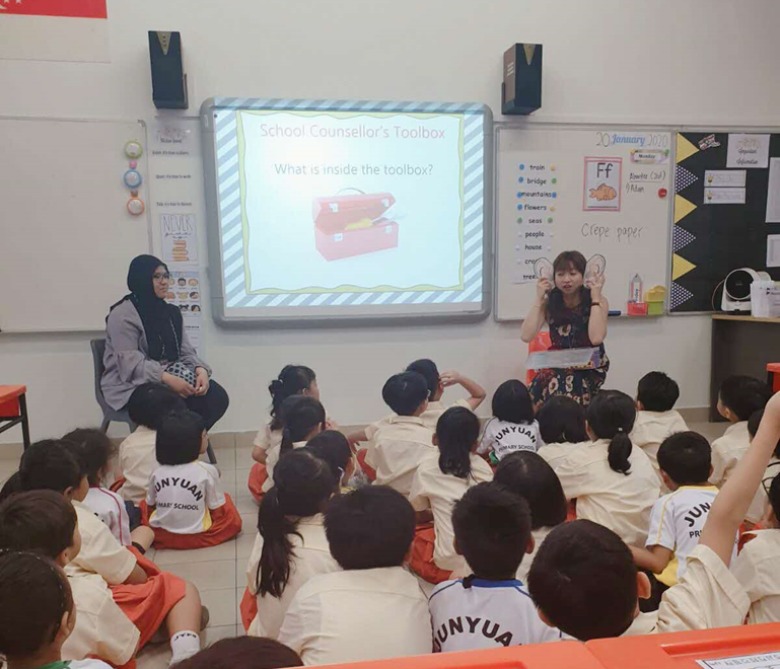
The brightly coloured School Counsellor’s Mailbox at the entrance of Junyuan Primary School’s canteen.
A colourful mailbox stands at the entrance of the Junyuan Primary School canteen to welcome the crowd of students who pour in at recess. Occasionally, a student would step forward to pick up a card from a stack nearby, scribble on it, and drop it into
the box.
The note would soon find its way to one of the school’s two school counsellors or teachers, who then reaches out discreetly to the student for a chat.
It is a quiet touchpoint, but an important one. The school counsellors recognise that some students may feel more comfortable to be approached by their school counsellor, than having to make the first move. Other students may not want to talk at first and prefer to start with note-writing. The school acknowledges this, while also offering social, mental and emotional support at a whole-school level.
Increasingly, schools, like Junyuan Primary, are going beyond the traditional one-to-one, talk-based counselling. They are reaching more students through a variety of approaches and touchpoints, so students don’t always need to go for counselling;
instead, the counselling goes to them.
The tiered-support system is best exemplified through a pyramid, where broad-based general support is provided to all students at Tier 1 by teachers and school counsellors, either through the Character and Citizenship Education (CCE) syllabus or through
school-wide outreach like assembly talks.
At Tier 2, students with greater needs are identified early, with intervention promptly given to these students. Tier 3 focuses on students who need more intensive intervention.

The tiered-support system is designed to provide tailored support for students with different levels of needs.
Shift in emphasis on mental health towards prevention
“Counselling used to be more reactive,” says Ms Phun Win Lin, Senior School Counsellor at Junyuan Primary School. “When a case is referred or if there is a crisis, the school counsellor then steps in to provide emotional and social support
for the child and family.
“But there has been a great shift in emphasis on mental health. If we have robust preventive efforts in place, we hope that there will be fewer cases escalating into crises, and all students are also made more cognisant of what mental wellness entails.”
Wanting to provide early support, intervention and a culture of care, the school introduced the School Counsellor’s Mailbox in 2013 as a Tier-1 approach for the school to teach help-seeking to their students. It also builds trust in their students
that they will be heard.
As students pen their thoughts, there are also questions on the card designed to guide the students to ponder on the issue they are facing and pinpoint the problem.
The notes are collected periodically and assessed based on levels of need and support required. The school counsellors and teachers follow up and have conversations with students on problems they face at home, with their studies, or between friends.
There are times that the students share about what appears to be less serious to them, but the school counsellors are trained to read into the problem.
Says Mr Daniel Anand Kolandai, the school’s Head of Department of Student Management, “At their young age, they may not know how serious some of the issues that they are facing are, and the mailbox notes help with the early identification
of those at risk.”
 The cards are designed differently for lower and upper primary students, with guiding questions to walk the students through processing their emotions.
The cards are designed differently for lower and upper primary students, with guiding questions to walk the students through processing their emotions.
Café that serves up mental wellness round the clock
At a unique “dining venue” in Junyuan Primary, there are no food items listed on the menu, nor a kitchen even.
Kids Café is a one-stop online portal offering a mental wellness menu of journaling tools, mini games, breathing exercises, and – who can say no to this? – live video feeds of the animal residents at the renowned San Diego Zoo.

There are different theme rooms in the Kids Café, offering a variety of activities for students to partake in.
It is another example of the whole-school approach to supporting students’ well-being at the school, launched at the height of the Covid-19 pandemic when the school sought ways to help students cope with social isolation and Covid-19 related
stressors.
Various school departments – Aesthetics (Art, Music), Information and Communications Technology, English Language, CCE, along with the School Counsellors and Year Heads – came together to develop resources on mental wellness and offer
help online.
Students can log in to the “café” through the school’s website in their own time, pick an activity for fun and relaxation, or soak in the advice on how to deal with stress and anxiety. Students who are feeling down can also
seek help through a curated list of helplines and resources found on the site, or even try breathing techniques to calm down.
“We wanted to build on the idea of self-care and self-management, and empower our students to take care of themselves,” says Ms Phun. Though the pandemic has abated, the platform is still being accessed regularly; students have given feedback
to say it has indeed helped them to better manage their feelings and build resilience. Teachers also incorporate its use into their lessons, as a source of reward or learning.
More targeted support and tailored help
Apart from general outreach, school counsellors find ways to strengthen the support around students who require help covered under Tier 2 support.
Nan Chiau High School’s Senior School Counsellor Joana Leong notes how teenagers may prefer to turn to their peers for advice, and was thinking of ways to facilitate this.
One day, she was observing how her students at the school bus stop were occupied with scrolling through comics on their mobile phones, and had a brainwave. “It is easier to reach out to a mobile phone than an adult about certain issues,”
she says. “We have to stay relevant and be creative to meet the students where they are.”
Mdm Leong mooted her idea and collaborated with the Teacher-in-charge of the school’s Art Talent Programme, Mr Johnson Ong, to rally over 20 students to produce an anime-inspired online comic book titled Nanime (coined by combining “Nan
Chiau” and “anime”).
“Nanime, like many of our other programmes, is ‘By Students, For Students’,” explains Mdm Leong. “The comics are written and drawn by their peers who may go through the same issues, and they can resonate and take something
away from it.” Some of the themes that emerged were hard-hitting, such as “the hopelessness of life”; they demonstrated an understanding of what bothered the teens, and offered alternative views to shift perspectives.
The anime-style comics were conceptualised and drawn by students, with Mdm Leong providing guidance on the content pertaining to mental health and sharing tips. The CCE teachers also helped students weave in coping strategies learned during
CCE lessons into the storylines.
.jpg)
A storyline in Nanime about a distressed student, and how the CHEER framework (Calm down, Hear, Empathise, Encourage and Reach Out) was used to guide the peer’s response.

Storylines based on exam stress, and the role of friendships when supporting peers.
With the intention to raise mental wellness among the students, these comics also serve as vignettes and topics of discussions in CCE lessons and Peer Support Leaders’ activities, as well as for students in need of social and emotional support in
the counselling setting.
At Junyuan Primary School, another kind of Tier 2 programme was designed to offer early and targeted help.
The school counsellors stage a Meet & Greet at the start of the new school year, making their rounds to all Primary 1 classes to introduce themselves.
 The Counsellor’s Toolbox is brought around by the school counsellors, with quirky props to make the Meet and Greet sessions fun and interactive.
The Counsellor’s Toolbox is brought around by the school counsellors, with quirky props to make the Meet and Greet sessions fun and interactive.
 Ms Phun (right), pictured with a pair of giant ears, and Mdm Sharifah demonstrating to the new P1 students that the school counsellors are always ready to listen.
Ms Phun (right), pictured with a pair of giant ears, and Mdm Sharifah demonstrating to the new P1 students that the school counsellors are always ready to listen.
Ms Phun noted the importance of learning about social and emotional wellness from a young age. “Knowledge of these issues would translate to helping them build up their soft skills, and life skills such as coping with their emotions,”
she says.
“They enter our school at a young and impressionable age,” echoes Mr Daniel. “By the time they leave primary school, they would have grown and learnt to manage themselves and more importantly know that they are not alone.”
The school’s Tier 2 structures also support students identified to be at-risk or already dealing with issues such as self-harm, familial problems or even those that affect cyber offences such as spreading misinformation online. In-school programmes
and activities are initiated by the School Counsellors and student management team – including group talks, games, and personal check-ins – depending on the students’ specific needs.
“Our objective is simple: We want to put the word out there that support will be there, if you are indeed facing any issue,” says Mr Daniel.
Counselling at a personal level
Apart from preventive measures, there are measures in place for those students who require more targeted intervention. Though such counselling is more personal in nature (Tier 3 support), it does not necessarily take place within a school’s
Counselling Room.
This stereotype “may make a student more resistant to seeking help”, says Mdm Leong, who tries not to sit a student down in her room for their chats. Secondary school students are by nature not as forthcoming about their mental health
issues, she says; they may see help-seeking as a sign of vulnerability and not want to come under the scrutiny of their peers.
“The last thing they want to do is to be called up and made to go through a programme.”
Enter the school’s “physical” POP Café, a quaint corner of the school where students hang out during recess or after school to unwind and grab a snack. Students like the relaxed vibe, and Mdm Leong is a familiar face there.

Mdm Leong, in front of the POP Cafe, where she is a familiar face. Anyone, whether in need or not, is free to speak with her.
She recalls how a student once sidled up for a chat, and went on to confide that there was a schoolmate who may be troubled and engaging in self-harm. When she approached the schoolmate to offer help, the student also requested to meet her at the
café and not the counselling room.
“Support isn’t limited to the confines of my Counselling room, it can be anywhere in the school,” says Mdm Leong. Her words may well summarise the move in schools towards making counselling support more accessible to all students.
“Most importantly, the environment must be comfortable for the students to share their issues.”






.jpg)